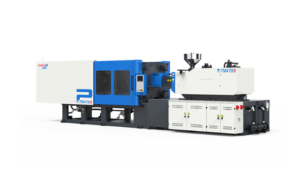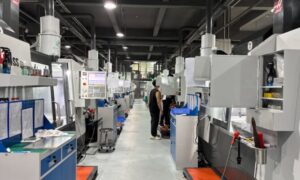Have you ever wondered how that bag of chips or shampoo gets perfect packaging? The answer lies in the fascinating world of industrial packaging machines! This will show you the gear that quietly and diligently operates in the background to ensure your favorite things get to you safely.
You will examine the unsung heroes of the packaging business, from filling machines that perfectly dispense liquids and powders to palletizers that neatly stack boxes with robotic precision.
Categorizing Industrial Packaging Machine
-
Filling Machine
These multipurpose workhorses are in charge of accurately dispensing goods into containers, whether liquids, powders, granules, or pastes. Different product types and desired fill volumes are catered for by the various configurations available in filling machines, including volumetric, auger, and piston fillers.
-
Forming, Filling and Sealing (FFS) Machines
These multi-talented machines provide a one-stop shop, as their name implies. Film or foil are used as raw materials, which are then formed into pre-made containers, filled with the product, and sealed for a tight closing. Pharmaceuticals, baked goods, and snacks are among the products that are frequently packaged with FFS machines.
-
Wrapping and Sealing Machines
The process of wrapping and sealing things begins after they have been filled and enclosed. These machines use various materials to attach the containers on pallets or individual units, such as tape, shrink wrap, or stretch wrap. This keeps goods stable while in transit and shields them from tampering, moisture, and dust.
-
Labeling Machines
Labeling machines attach pre-printed labels on containers, adding the final details and important data. These labels may have vital safety information, barcodes, branding components, or product details. Labeling machines improve brand recognition on store shelves and guarantee product conformity with standards.
-
Palletizing and Depalletizing Machines
Palletization is essential for large-scale product movement. These automated systems effectively stack filled and sealed containers for storage and transit atop pallets safely and orderly. On the other hand, offloading is done by depalletizing machines, which carefully take pallets out of stacks and distribute individual containers.
Exploring Specific Packaging Machine Types
1) Filling Machines
a) Auger Fillers
These devices measure and distribute dry, free-flowing materials like powders, grains, or flakes accurately using a spiraling screw. Auger fillers are perfect for detergents, Coffee, and spices because they provide precise and reliable filling.
b) Volumetric Fillers
When it comes to volumetric fillers, simplicity is paramount. They use a preset cavity size to measure the volume of the product. This method works well for liquids and free-flowing materials where uniformity is less important. Volumetric filling is often used for cleaning solutions, sauces, and beverages.
c) Piston Fillers
Piston fillers are used for very viscous liquids and pastes, such as toothpaste, mayonnaise, and creams. They use a piston inside a cylinder to generate a vacuum, pull in the product, and dispense it precisely.
2) Forming, Filling and Sealing (FFS) Machines
a) Vertical Form Fill Seal (VFFS) Machines
As the name suggests, these workhorses are vertical machines. Using a roll of film, they form pouches, stuff them with merchandise, and then seal them. It is basically a bottle filling machine where Coffee, chips, and medications are frequently packaged using VFFS equipment.
b) Horizontal Form Fill Seal (HFFS) Machines
HFFS machines run horizontally and are excellent at packaging bulkier commodities such as frozen food, medical supplies, and baked goods. After forming a film tube and adding product, they seal both ends to ensure a tight closure.
3) Wrapping and Sealing Machines
a) Shrink Wrap Machines
Shrink wrap machines rely heavily on heat. They apply regulated heat after covering goods or pallets with a loose plastic film. This produces a tight, tamper-evident seal by shrinking the film around the items.
b) Stretch Wrappers
Pallets are stabilized and secured during transit with stretch wrappers, which encircle the pallets with a thin, elastic membrane. Things can’t move or topple over because the film stretches and exerts tension on the weight.
c) Carton Sealers
Carton sealers guarantee the closure of products once they are securely enclosed within cartons. These devices firmly seal the carton flaps to protect the contents from dust, moisture, and tampering. They do this by using pressure-sensitive tape or hot melt glue.
4) Labeling Machines
a) Pressure Sensitive Labelers (PSLs)
These adaptable devices directly apply pre-printed labels on goods containers. Pressure-sensitive labels (PSLs) guarantee that labels stick firmly on various surfaces.
b) Sleeve Labelers
Sleeve labelers use pre-cut plastic sleeves for a clean, tamper-evident finish. To create a neat and appealing seal, the sleeve is wrapped around the container and shrunk with heat or steam.
5) Palletizing and Depalletizing Machines
a) Pallet Stackers
These automated devices are the focal point of large-scale manufacturing plants. Effortlessly lifting and piling packed and sealed boxes onto pallets establishes sturdy and safe arrangements for transit and storage.
a) Pallet Wrappers
Pallet wraps are used after the pallets are stacked. These devices secure the load and reduce the possibility of damage during transit by rotating the pallet while applying layers of stretch film.
c) Depalletizers
Palletizers at the receiving end of the supply chain facilitate the unloading operation. They carefully remove individual containers from pallets using robotic arms or vacuum technology to ensure effective product distribution.
Conclusion
So, there you have it! Now, you have looked at the fascinating world of industrial packaging machines, from the filling funnels of filling machines to the high-fiving robots of palletizers. Recall that effective packaging ensures that your goods arrive on store shelves in perfect condition and create a big impression.



































